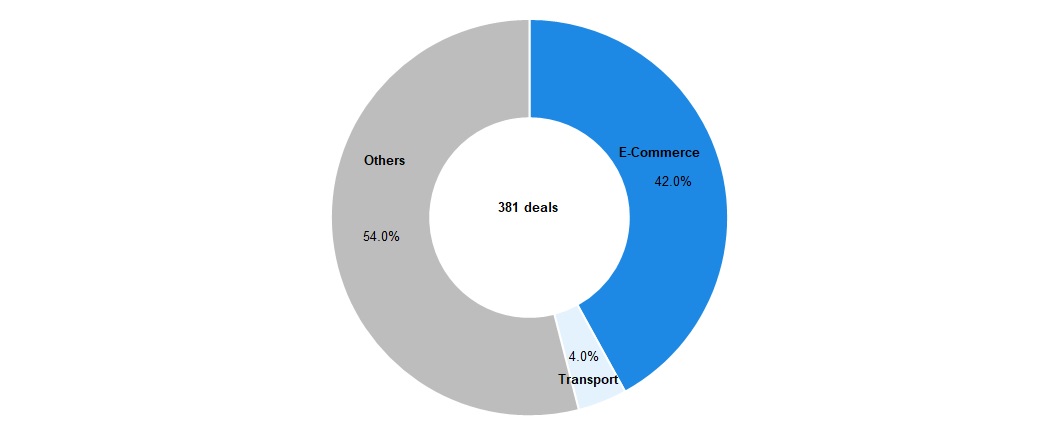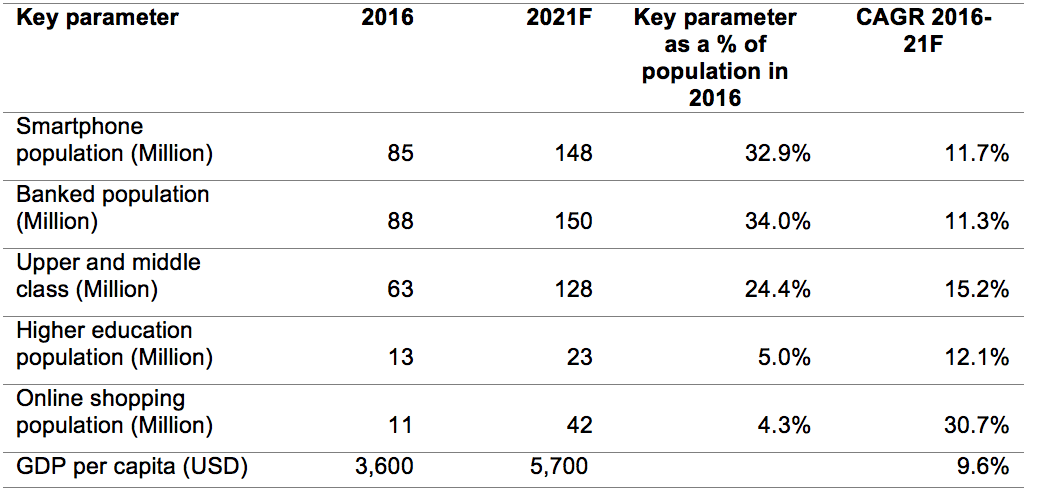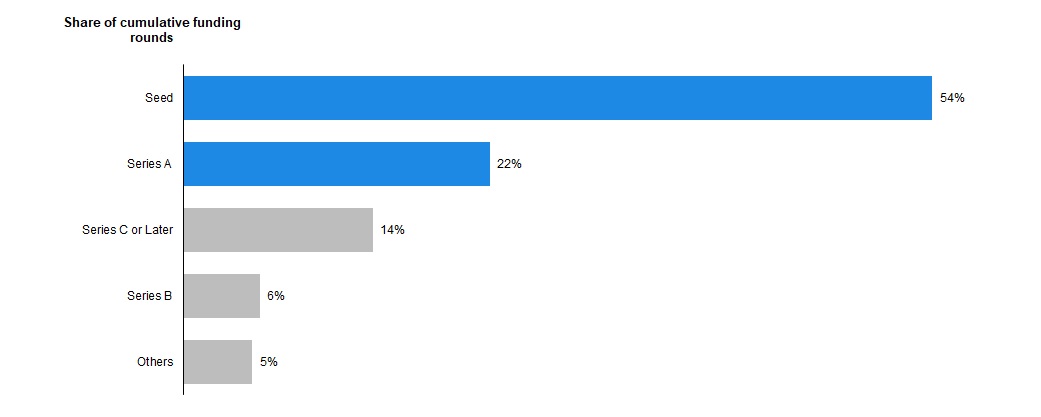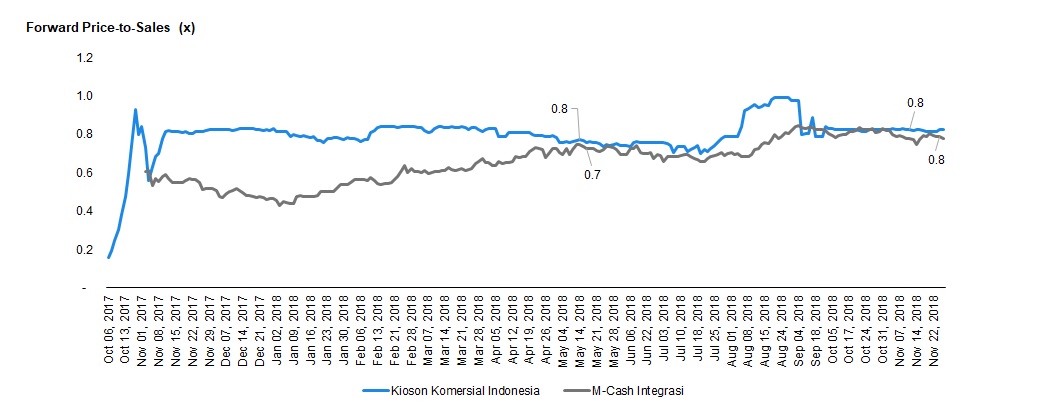Indonesian Start-ups: Will the New Tech Board Help Boost IPOs?
|
Investments in start-ups in Indonesia increased significantly (by 68 times) in 2017 YTD (January to August) to USD 3 billion from a low base of USD 44 million in 2012, according to a study conducted by AT Kearney and Google. This makes Indonesia the second most popular destination in Southeast Asia (SEA) for investment in start-ups, after Singapore. |
|
Venture capital (VC) investors have continued to invest in Indonesian start-ups due to the country’s expanding digitally knowledgeable population and rising per-capita income. Moreover, the ratio of VC investments to GDP in Indonesia continues to lag behind SEA peers’, indicating growth potential. Despite rising investments in recent years, weak exit infrastructure remains a challenge: Indonesia lacks an exchange specifically designed for the trading of shares in start-ups. Currently, most exits occur through M&A; IPOs are relatively rare. |
|
In order to encourage more start-ups to raise capital as well as to allow faster exits for early investors through the stock market, the government plans to relax listing requirements and establish a new dedicated technology section (a new ‘technology board’) within its main stock exchange for the trading of shares in start-ups by 2019 (Jakarta Globe). This new technology board will have less stringent requirements than either the main board or the development board, as it gives start-ups up to six years to turn profitable. |
|
However, the new technology board is unlikely to drive significant IPO activity in start-ups over the short term, given that most were established only over the past three to five years and their failure rate is 90% (the rate is based on Indonesia’s Creative Economy Agency). We expect only a gradual increase in IPO activity from the fast-growing but unprofitable ‘non-VC-backed’ start-ups, as the new board provides them an alternative source of funding. As for VC-funded start-ups, there may not be many that will exit via IPOs anytime soon, given that VC investments have just picked up over 2015–17. Local unicorns have also made statements that IPOs will be years away, as their focus is currently on expanding market share and turning profitable. |
|
In terms of valuation, local unicorn Bukalapak currently has an estimated price-to-sales ratio of 63.3x as of 2017. This suggests that the company still needs to grow its top line significantly, given that the public market is willing to pay only around 0.7–0.8x of sales, based on our observation on the performance of two newly listed start-ups over October 2017- November 2018. In our view, the listing of one of these unicorns on IDX will be the main trigger for a meaningful increase in IPO exits, as it should provide greater clarity on the fair market valuation of Indonesian start-ups. |
|
Investments in Start-ups Up Exponentially, Driven by Tech Fluency and Rising Income |
|
Based on a study conducted by AT Kearney and Google, the start-up landscape in Indonesia, although in its nascence, is expanding rapidly. This has been driven by investments (by both local and foreign investors, i.e. VCs and local and global conglomerates), which increased by around 68 times to USD 3 billion in 2017 (January to August) from a low base of USD 44 million in 2012. Investment volume also increased substantially by around three times to 54 deals over 2012–August 2017, after peaking at 123 deals in 2016. This has boosted Indonesia’s contribution to start-up investment value in the SEA region to about 46% in 2017 (January to September), based on CB Insights’ data (out of USD 6.4 billion), from just 3% in 2013 (as per AT Kearney and Google). Indonesia therefore ranks second among popular destinations for investment in start-ups in the SEA region, behind Singapore (contribution in 2017: 47%). The e-commerce segment led in both investment value and volume in Indonesia over this period, with shares of around 58% and 42% respectively. |
|
Moreover, based on data compiled from Inc42, Index.co and Crunchbase, the top 20 start-ups in Indonesia accounted for the bulk of cumulated investment value over 2012–August 2017 with an 83.3% share (out of approximately USD 5.4 billion, as per AT Kearney and Google), indicating the smaller deal size of the remaining investments. In 2017 alone, Go-jek (ride-hailing, logistics, and digital payments), Tokopedia (online marketplace), and Traveloka (online travel aggregator) together received total investments of USD 2.8 billion from Tencent, Alibaba, and Expedia respectively as per CB insights, representing around 93% of the total investment in start-ups during that year. |
|
As per AT Kearney and Google, VC investors view the Indonesian market positively due to the country’s expanding digitally fluent population and rising income. Key parameters are expected to improve further over 2016–21F. These parameters include smartphone users (11.7% CAGR over 2016–21F; 32.6% of the population in 2016), the banked population (11.3% CAGR; 33.7% in 2016), the population with higher educational attainment (12.1% CAGR; 5.0% in 2016), the online shopper population (30.7% CAGR; 4.3% in 2016), and GDP per capita (9.6% CAGR). Moreover, the ratio of VC investments to GDP continued to lag behind SEA peers’, suggesting room for further growth (Indonesia’s came in at 0.15% in 2016, much lower than the SEA average of 0.28%). |
|
Although Indonesia has attracted a large number of investments in recent years, exit infrastructure remains relatively weak. So far, Indonesia has not established an exchange specifically designed to trade shares of tech start-ups (i.e. an exchange that could guarantee the liquidity of tech start-ups). Other countries have already established third market boards to help small but fast-growing companies to raise capital through IPOs and to allow faster exits for investors. For example, China established one as early as 2006 and South Korea in 2013. |
|
Impressive Growth in Start-up Investments |
|
|
|
Source: AT Kearney and Google |
|
Note: 2017 figure is for January-August |
|
Indonesia’s Contribution to Start-up Investments in SEA Sees Marked Growth |
|
|
|
Source: AT Kearney and Google; CB Insights |
|
Note 1: 2017 figure is for January-September 2017 |
|
Note 2: 2013-16 data includes countries in Southeast Asia; 2017 data includes only ASEAN-5 countries (Singapore, Indonesia, Malaysia, Thailand, and the Philippines) |
|
E-Commerce and Transport Dominated Investment Value, 2012–August 2017 |
|
|
|
Source: AT Kearney and Google |
|
E-Commerce Dominated Investment Volume, 2012–August 2017 |
|
|
|
Source: AT Kearney and Google |
|
Mega Rounds Raised by Local Unicorns Dominated Investment Value in 2017 |
|
|
|
Source: CB Insights |
|
Note: As per Crunchbase, Series A and Series B rounds are funding rounds for earlier-stage companies; Series C rounds and onwards are for later-stage or more established companies |
|
Demographics and Per-Capita Income to Expand Further over 2016–21F |
|
|
|
Source: AT Kearney and Google; Statista |
|
Note: CAGR and proportions computed by UZABASE |
|
Larger Tech Companies’ Increasing Acquisitions Drive Consolidation Among Start-ups; IPO Activities by Non-VC-Backed Start-ups Emerging Gradually |
|
Based on data compiled from Index.co and MDI Ventures, the number of exits via M&A increased to 12 in 2017 in Indonesia, from just 1 in 2010. Over 2010–17, there were 28 exits through trade sales (i.e. being acquired) and 4 via mergers, with the majority of them acquired by tech peers. For instance, Go-jek acquired four fintech firms throughout 2016-17: MVCommerce Indonesia, Midtrans, Kartuku, and Mapan. Moreover, Blibli acquired Indonesia Flight and Tiket in 2017. These strategic acquisitions by larger tech companies indicate an increasing trend of consolidation among start-ups (MDI Ventures). We note that seven of these exits (accounting for a mere 1.8% of the 381 cumulative VC deals over 2012–August 2017) were by VC-backed start-ups. This shows that the majority of VC investors have not exited their investments. Meanwhile, non-VC-backed start-ups accounted for the other 7 exits (investor information is unavailable for the remaining 18 exits). Trade sale is preferred by many start-ups in Indonesia due to its lower market risk versus IPOs, especially if their estimated market values are lower than their book values (the International Comparative Legal Guides [ICLG]). |
|
Furthermore, many early-stage start-ups find it difficult to obtain the funding necessary to expand until they reach the IPO stage. Over 2012–August 2017, the cumulative number of seed funding rounds accounted for 54% (or 205 deals) of the total cumulative deals (381); the cumulative number of Series-A funding rounds stood at only around half of that (22%, or 84 deals), indicating that the majority of start-ups could not raise further funding after the seed stage. Most investors have become increasingly interested in funding more mature start-ups with higher earnings visibility. As per AT Kearney and Google, the share of Series-C funding rounds and above increased to 43.3% in 2017 (January-August) from 28.6% in 2016. Given that most start-ups are likely to have issues in securing funding to finance growth, this trend of acquisitions of smaller start-ups by larger ones is likely to continue. |
|
On the other hand, exiting or/and fundraising via IPOs is emerging gradually, albeit remaining rare, mainly due to strict IPO requirements and valuation risk, as per ICLG. There are only four publicly listed start-ups in Indonesia, three of which had a combined market capitalisation of IDR 6.7 trillion in October 2018, or a mere 0.1% of IDX’s market capitalisation. All four are non-VC-backed start-ups. The first start-up IPO on the development board was Kioson’s (October 2017). Kioson’s main rationale behind the IPO was that it could not raise funding from VCs at the right valuation. Meanwhile, the other three IPOs were conducted by M Cash Integrasi (a digital self-kiosks provider), NFC Indonesia (a phone credit marketplace and a subsidiary of M Cash), and Yelooo Integra Datanet (modem Wi-Fi rental) within a year after the first, in November 2017, July 2018, and October 2018 respectively. The market responded positively to the four listings: their initial offerings were oversubscribed by around 7–10x. The market’s positive reaction is likely to encourage other non-VC-backed start-ups to follow suit. |
|
Number of Exits via M&A Up During 2014–17 |
|
|
|
Source: Compiled by Uzabase based on data published by Index.co and MDI Ventures |
|
Note: This chart only include exits made by local companies through trade sales and merger |
|
Cumulative Number of Seed Funding Rounds Around Twice That of Series-A, 2012–August 2017 |
|
|
|
Source: Computed by UZABASE based on data published by AT Kearney and Google |
|
Note 3: As per Crunchbase, Series A and Series B rounds are funding rounds for earlier-stage companies; Series C rounds and onwards are for later-stage or more established companies |
|
Emerging IPO Activities on Development Board by Non-VC-Backed Start-ups over 2017–18 |
|
|
|
Source: Compiled by UZABASE from information published by DailySocial, Investing.com, Kontan, and Katadata |
|
Note: Market capitalisation and share price information for Yelooo Integra Datanet is not available |
|
Government to Relax Listing Requirements and Establish Technology Board by 2019 to Encourage IPOs by Start-ups |
|
Many start-ups are ineligible to float their shares on IDX, given the government’s requirement that companies become profitable after two years of being listed. For instance, Go-jek stated in 2018 that aside from issues such as financial reporting compliance, it is not ready to be listed on IDX, as the company does not expect to become profitable yet, as per Indonesia-Investments (i.e. its business model has not fully matured). In order to encourage more Indonesian start-ups to raise capital in the stock market and to allow faster exit for their investors, the government plans to implement the following: |
|
1) Loosen IDX’s listing regulations by giving start-ups up to six years from their initial offering dates to become profitable |
|
2) Establish a dedicated technology board within its main stock exchange to trade tech start-up shares by 2019 (Jakarta Globe) |
|
Aside from IDX’s existing requirement for IPO candidates to generate profit after two years of being listed, they also must fulfil the minimum net tangible asset (NTA) and operational history requirements. The main board has stricter regulations than the development board on NTA and operational history. As for the new technology board, the government plans to allow start-ups to combine their intangible and tangible assets in order to meet the net asset requirement (Detik Finance). This is because intangible assets normally account for a large proportion of start-ups’ assets. |
|
Given that the listing of start-ups on the development board emerged gradually during 2017–18, the government is likely to be interested in setting up the new technology board. It is important to note that all four newly listed start-ups have generated net profits at the time of their IPOs (although two of them recorded net losses just a year prior to the IPOs). Moreover, the government will likely want to see local start-ups (especially the four Indonesian unicorns: Go-jek, Tokopedia, Traveloka, and Bukalapak) listed on IDX rather than in overseas markets. In April 2016, local online payment company Kinerjapay stated that one of the main reasons for the company to be listed on the USA’s over-the-counter (OTC) market was due to stricter listing requirements in Indonesia (e.g. revenue and asset requirements), as per Kontan. |
|
Technology Board to Have More Lenient Requirements on Profitability |
|
|
|
Source: Compiled by Uzabase from information published by DailySocial and Detik Finance |
|
Note: *The technology board will include intangible assets |
|
IPO Activity by Fast-Growing but Unprofitable Start-ups Increasing Gradually; Listing of a Unicorn on IDX Might Trigger IPO Exits |
|
Generally, a start-up will not be willing to conduct an IPO when its estimated market value is below its book value (or below the most recent valuation paid by its VC investors). The post-money valuation of start-ups is normally determined by their most recent investments received and the percentage of equity ownership given to investors. If the estimated market value of a start-up is lower than the book value, an IPO may not be a prudent step, as it could result in capital loss for early investors. Since the new technology board will allow start-ups to become listed companies even without generating profits, a price-to-sales multiple or an enterprise value/sales multiple could be the more appropriate metric for estimating the market value of Indonesian tech start-ups. In the absence of detailed financials for private companies, we use the price-to-sales multiple for a meaningful comparison with those of listed companies. |
|
Based on our observation on the performance of the two newly listed start-ups, they have increased their revenues significantly beyond their book values (around 4–14x higher). Moreover, their shares are currently trading at a forward price-to-sales ratio of around 0.7–0.8x during October 2017–November 2018. Consequently, only the start-ups that are able to grow their revenues beyond their net assets (or the most recent valuation paid by VC investors) may consider getting listed on the new technology board. Overall, a majority of Indonesian start-ups have not yet reached this stage, given that most were established only over the past three to five years, with a failure rate of 90% (the rate was published by Kompas Tekno based on Indonesia’s Creative Economy Agency). The cumulative number of new established start-ups over 2015–17, at 1,006, represented 59.0% of the total start-ups outstanding in the country as of February 2018 (1,705 companies as per Start-up Ranking). Hence, we do not expect the new technology board to drive IPO activity significantly over the short term. We expect only a gradual increase in IPO activity coming from fast-growing non-VC-backed start-ups (not necessarily profitable yet), as the new board offers an alternative source of funding. |
|
As for VC-backed start-ups, there may not be many that will exit through IPOs anytime soon, given that VC investments have just picked up over 2015–17. Investment in start-ups over 2015-August 2017 accounted for 93.7% of the cumulated investment value over 2012-August 2017. VC investors generally have a 5–8-year time horizon and require a return of 3–5x of their investments (MDI Ventures). Hence, the majority of these VC-backed start-ups may remain focused to grow business operations. Local unicorns have also made statements that exiting via IPOs is years away while expanding their market share and turning profitable remain key priorities. |
|
In terms of valuation, Bukalapak has an estimated price-to-sales multiple of 63.3x, based on a valuation of USD 1 billion and estimated revenue of USD 15.8 million (or IDR 240 billion, as per detik.com) in 2017 (due to the unavailability of revenue estimates, the price-to-sales ratios for the other three unicorns are not computed). This indicates that Bukalapak still needs to improve revenue significantly in order to justify its current valuation, given that the public market is currently willing to pay only 0.7–0.8x of start-ups’ revenue. In our view, the listing of one of these unicorns on IDX should be the main trigger for a meaningful increase in IPO exits, as it provides greater clarity on how the public market assesses the valuation of Indonesian start-ups. |
|
Newly Listed Start-ups to Grow Revenue Significantly Beyond Net Assets, 2018E |
|
|
|
Source: Company filings |
|
Note 1: Revenue and net asset figures are based on 2H 2018 annualised figures |
|
Note 2: The annual growth in revenue is based on 2H 2018 annualised figures |
|
Listed Start-up Shares Are Trading at Forward Price-to-Sales Ratio of 0.7–0.8x |
|
|
|
Source: Computed by UZABASE based on data published by Investing.com and company filings |
|
Number of Newly Established Start-ups Peaked in 2015 |
|
|
|
Source: Bisnis Indonesia, and DailySocial |
|
Majority of New Start-ups Were Established Over Past Three to Five Years |
|
|
|
Source: Computed by Uzabase based on data published by Bisnis Indonesia, Start-up Ranking, and DailySocial |
|
VC Investment in Start-ups Have Increased Just Recently (over 2015–August 2017) |
|
|
|
Source: Computed by UZABASE based on data published by AT Kearney and Google |
|
Appendix |
|
Top 20 Start-ups Accounted for More than Three-Quarters of Cumulative Investments Disclosed by VCs and Large Corporates over 2012–August 2017 |
|
|
|
Source: Compiled by UZABASE from data published by Inc42, Index.co, Crunchbase and Tech in Asia |
|
Note 1: Table includes only investments up to August 2017 |
|
Note 2: Table does not include funding raised through IPOs and initial coin offerings (ICOs) |
|
Note 3: As per Crunchbase, Series A and Series B rounds are funding rounds for earlier-stage companies; Series C rounds and onwards are for later-stage or more established companies |
|
Increasing Acquisitions by Larger Tech Companies, 2010–17 |
|
|
|
Source: Compiled by UZABASE based on data published by Index.co, MDI Ventures, and Crunchbase |




















